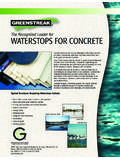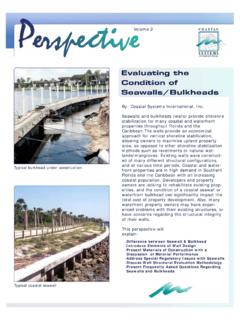Transcription of Segmental Concrete Bridges - Free
1 Sauvageot, G. Segmental Concrete Bridges .. bridge Engineering Handbook. Ed. Wai-Fah Chen and Lian Duan Boca Raton: CRC Press, 2000. 11. Segmental Concrete Bridges Introduction Balanced Cantilever Girder Bridges Overview Span Arrangement and Typical Cross Sections Cast-in-Place Balanced Cantilever Bridges Precast Balanced Cantilever Bridges . Loads on Substructure Typical Post-Tensioning Layout Articulation and Hinges Progressive and Span-by-Span Constructed Bridges Overview Progressive Construction . Span-by-Span Construction Incrementally Launched Bridges Overview Special Requirements Typical Post-Tensioning Layout Techniques for Reducing Launching Moments Casting Bed and Launching Methods Arches, Rigid Frames, and Truss Bridges Arch Bridges Rigid Frames Segmental Trusses Segmental Cable-Stayed Bridges Overview Cantilever Construction In-Stage Construction Push-Out Construction Design Considerations Overview Span Arrangement Cross-Section Dimensions Temperature Gradients.
2 Deflection Post-Tensioning Layout Seismic Considerations Design Aspects and Design Codes . Deck/Superstructure Connection Casting and Erection Casting Erection Future of Segmental Bridges The Challenge Concepts New Developments . Environmental Impact Industrial Production of Gerard Sauvageot Structures The Assembly of Structures . J. Muller International Prospective 2000 by CRC Press LLC. Introduction Before the advent of Segmental construction, Concrete Bridges would often be made of several precast girders placed side by side, with joints between girders being parallel to the longitudinal axis of the bridge . With the modern Segmental concept, the segments are slices of a structural element between joints which are perpendicular to the longitudinal axis of the structure.
3 When Segmental construction first appeared in the early 1950s, it was either cast in place as used in Germany by Finsterwalder et al., or precast as used in France by Eug ne Freyssinet and Jean Muller. The development of modern Segmental construction is intertwined with the development of balanced cantilever construction. By the use of the term balanced cantilever construction, we are describing a phased construction of a bridge superstructure. The construction starts from the piers cantilevering out to both sides in such a way that each phase is tied to the previous ones by post-tensioning tendons, incorporated into the permanent structure, so that each phase serves as a construction base for the following one. The first attempts to use balanced cantilever construction, in its pure form, were made by Baumgart, who in 1929 built the R o Peixe bridge in Brazil in reinforced Concrete , casting the 68-m- long main span in free cantilevering.
4 The method did not really prosper, however, until the post- tensioning technique had been sufficiently developed and generally recognized to allow crack-free Concrete cantilever construction. From 1950, several large Bridges were built in Germany with the use of balanced cantilever construction with a hinge at midspan, using cast-in-place segments, such as Moselbr cke Koblenz, 1954: Road bridge , 20 m wide, with three spans of 101, 114, 123 m plus short ballasted end spans hidden in large abutments; the cross section is made up of twin boxes of variable depth, connected by the top slab. Rheinbr cke Bendorf, 1964: Twin motorway Bridges , 1,031 m long, with three main river spans of 71, 208, 71 m, built-in free cantilever construction with variable depth box sections. In France, the cantilever construction took a different direction, emphasizing the use of precast segments.
5 Precast segments were used by Eug ne Freyssinet for construction of the well-known six Bridges over the Marne River in France (1946 to 1950). The longitudinal frames were assembled from precast segments, which were prestressed vertically and connected by dry-packed joints and longitudinal post-tensioning tendons. Precast segments were also used by Jean Muller for the execution of a girder bridge in upstate New York, where longitudinal girders were precast in three segments each, which were assembled by dry-packed joints and longitudinal post-tensioning tendons. From 1960, Jean Muller systematically applied precast segments to cantilever construction of Bridges . It is characteristic for precast Segmental construction, in its purest form, that segments are match cast, which means that each segment is cast against the previous one so that the end face of one segment will be an imprint of the neighbor segment, ensuring a perfect fit at the erection.
6 The early milestones were as follows: bridge over the Seine at Choisy-le-Roi in France, 1962: Length 37+55+37 = 130 m; the bridge is continuous at midspan, with glued joints between segments (first precast Segmental bridge ). Viaduc d'Oleron in France, 1964 to 1966: Total length 2862 m, span lengths generally 79 m, with hinges in the quarterpoint of every fourth span; the segments were cast on a long bench (long-line method); erection was by self-launching overhead gantry (first large-scale, indus- trialized precast bridge construction). In the same period, precast Segmental construction was adopted by other designers for bridge construction with cast-in-place joints. Some outstanding structures deserve mention: 2000 by CRC Press LLC. Ager Br cke in Austria, 1959 to 1962: Precast segments placed on scaffold, cast-in-place joints.
7 R o Caroni in Venezuela, 1962 to 1964: bridge with multiple spans of 96-m each. Precast segments m long, were connected by cast-in-place joints to constitute the 480-m-long bridge deck weighing 8400 tons, which was placed by incremental launching with temporary intermediate supports. Oosterschelde bridge in The Netherlands, 1962 to 1965: Precast Segmental bridge with a total length of 5 km and span lengths of 95 m; the precast segments are connected by cast-in-place, joints and longitudinal post-tensioning. Since the 1960s, the construction method has undergone refinements, and it has been developed further to cover many special cases, such as progressive construction of cantilever Bridges , span-by- span construction of simply supported or continuous spans, and precast- Segmental construction of frames, arches, and cable-stayed bridge decks.
8 In 1980, precast Segmental construction was applied to the Long Key and Seven Mile Bridges in the Florida Keys in the United States. The Long Key bridge has 100 spans of 36 m each, with continuity in groups of eight spans. The Seven Mile bridge has 270 spans of 42 m each with continuity in groups of seven spans. The spans were assembled from precast segments placed on erection girders and made self-supporting by the stressing of longitudinal post-tensioning tendons. The construction method became what is now known as span-by-span construction. Comparing cast-in-place Segmental construction with precast Segmental construction, the fol- lowing features come to mind: Cast-in-place Segmental construction is a relatively slow construction method. The work is performed in situ, , exposed to weather conditions.
9 The time-dependent deformations of the Concrete become very important as a result of early loading of the young Concrete . This method requires a relatively low degree of investment (travelers). Precast Segmental construction is a fast construction method determined by the time required for the erection. The major part of the work is performed in the precasting yard, where it can be protected against inclement weather. Precasting can start simultaneously with the foundation work. The time-dependent deformations of the Concrete become less important, as the Concrete may have reached a higher age by the time the segments are placed in the structure. This method requires relatively important investments in precasting yard, molds, lifting gear, transportation, and erection equipment.
10 Therefore, this method requires a certain volume of work to become economically viable. Typically, the industrialized execution of the structure leads to higher quality of the finished product. Since the 1960s, the precast Segmental construction method has won widespread recognition and is used extensively throughout the world. Currently, very comprehensive bridge schemes, with more than 20,000 segments in one scheme, are being built as large urban and suburban viaducts for road or rail. It is reasonable to expect that the precast Segmental construction method, as introduced by Jean Muller, will contribute extensively to meet the infrastructure needs of humankind well into the next millennium. Balanced Cantilever Girder Bridges Overview Balanced cantilever Segmental construction for Concrete box-girder Bridges has long been recognized as one of the most efficient methods of building Bridges without the need for falsework.

















